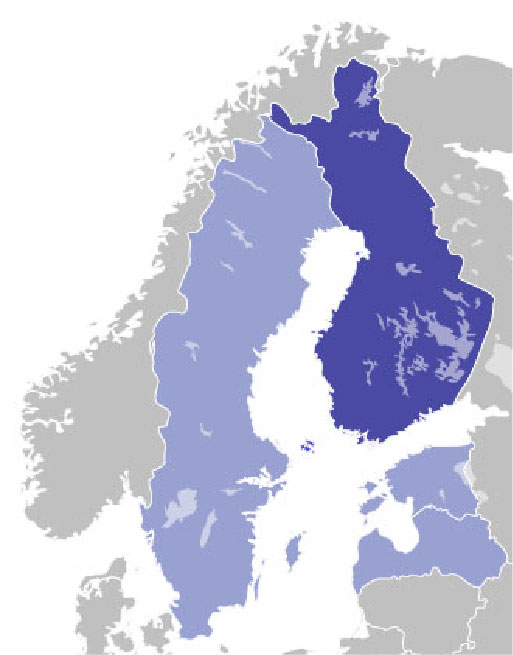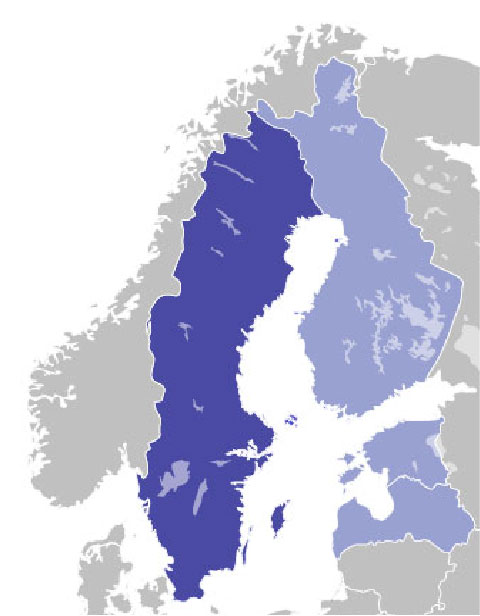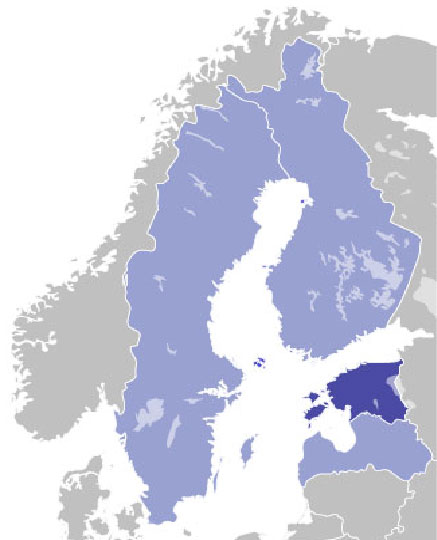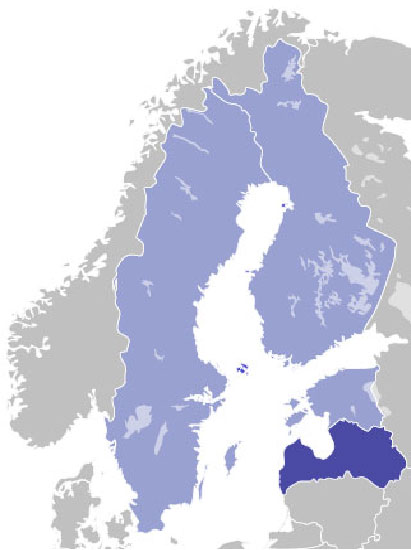
Central Baltic area
The Central Baltic area is in the North-Eastern part of the European Union, uniting the Nordic countries Sweden and Finland with two Baltic countries Estonia and Latvia. The area includes coastal regions of all programme countries for which the Baltic Sea is an important water body. The Baltic Sea has united the countries over centuries forming a basis for important and strong economic and cultural relations. Finland, Estonia and Latvia share a land border with Russia. Source
Finland

Country information
- population: 5,587,442
- currency: Euro
- languages: Finnish (official) 87.6%, Swedish (official) 5.2%, Russian 1.4%, other 5.8% (2018 est.)
- capital city: Helsinki
- main exports: refined petroleum, paper and wood pulp products, cars, stainless steel, lumber
- main imports: crude petroleum, cars and vehicle parts, refined petroleum, broadcasting equipment, packaged medicines
- political situation: Finland has transformed rapidly from an agricultural and forest economy to a diversified modern industrial economy. Per capita income in Finland is among the highest in Western Europe. Finland is a member of the EU since 1995 and was the only Nordic state to join the euro single currency at its initiation in January 1999. The key features of Finland's modern welfare state are high quality education, promotion of equality, and a national social welfare system. Finland is challenged by an aging population and the fluctuations of an export-driven economy. Finland is a stable society and very safe business environment.
- Finland is the only country in the world where all ports freeze in winter. Majority of Finnish imports and exports are passed by sea. Keeping ports open and navigation fluid during winter months is therefore vital for the country's highly industrialised economy.
Themes
Doing business in Finland
Sweden

Country information
- Capital city: Stockholm
- Area Total: 450,295 sq km
- Time difference: UTC+1
- Independence: 6 June 1523 (Gustav VASA elected king of Sweden, marking the abolishment of the Kalmar Union between Denmark, Norway, and Sweden)
- Population: 10,483,647 (2022 est.)
- Population Growth: 0.5% (2022 est.)
- Urban population: 88.5% of total population (2022)
- Electrification: 100% (2020)
- Government type: parliamentary constitutional monarchy
- Legislature: unicameral Parliament or Riksdag (349 seats; 310 members directly elected in multi-seat constituencies by open party-list proportional representation vote and 39 members in "at-large" seats directly elected by open party-list proportional representation vote; members serve 4-year terms)
- Legal system: civil law system influenced by Roman-Germanic law and customary law
- Language: Swedish (official). Finnish, Sami, Romani, Yiddish, and Meankieli are official minority languages
- Religion: Church of Sweden (Lutheran) 57.6%, other (includes Roman Catholic, Orthodox, Baptist, Muslim, Jewish, and Buddhist) 8.9%, none or unspecified 33.5% (2019 est.)
- Currency: Swedish kronor
Themes
Doing business in Sweden
Estonia

Country information
-
- Government type: parliamentary republic
- Legislature: unicameral Parliament or Riigikogu (101 seats; members directly elected in multi-seat constituencies by open- list proportional representation vote to serve 4-year terms)
- Legal system: civil law system
- Language: Estonian (official) 68.5%, Russian 29.6%, Ukrainian 0.6%, other 1.2%, unspecified 0.1% (2011 est.)
- Religion: Orthodox 16.2%, Lutheran 9.9%, other Christian (including Methodist, Seventh Day Adventist, Roman Catholic, Pentecostal) 2.2%, other 0.9%, none 54.1%, unspecified 16.7% (2011 est.)
- Capital city: Tallinn
- Area Total: 45,228 sq km
- Time difference: UTC+2
- Independence: 24 February 1918 (from Soviet Russia); 20 August 1991 (declared from the Soviet Union); 6 September 1991 (recognized by the Soviet Union)
Population: 1,211,524 (2022 est.) - Population Growth: -0.71% (2022 est.)
- Urban population: 69.6% of total population (2021)
- Electrification: 100% (2020)
Themes
Doing business in Estonia
Latvia

Country information
- Population: 1 893 223
- Currency: Euro (EUR)
- Language: Latvia
- Capital city: Riga
- Main exports: sawn wood, broadcasting equipment, hard liquor, wheat, packaged medicaments
- Main imports: refined petroleum, broadcasting equipment, cars, packaged medicaments, planes, helicopters, and/or spacecraft
- Political situation: Latvia is a member state of the European Union – the largest single market in the world. The country fulfilled the Maastricht criteria and joined the Eurozone on January 1, 2014. Since 2016 it is a member of the Organisation for Economic Co-operation and Development (OECD
- Other relevant aspects: Four cornerstones of the Latvian economy are agriculture, chemicals, logistics and woodworking. Other prominent sectors include textiles, food processing, machinery production and green technologies